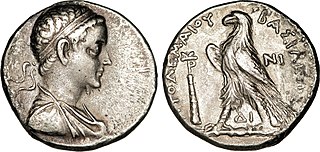Related Research Articles
Year 202 BC was a year of the pre-Julian Roman calendar. At the time it was known as the Year of the Consulship of Geminus and Nero. The denomination 202 BC for this year has been used since the early medieval period, when the Anno Domini calendar era became the prevalent method in Europe for naming years.

Ptolemy V Epiphanes, son of the siblings Ptolemy IV Philopator and Arsinoe III of Egypt, was the fifth ruler of the Ptolemaic dynasty from July/August 204 to September 180 BC.
In Greek mythology, Tlepolemus was the leader of the Rhodian forces in the Trojan War.

Efyra is a village and a community in the western part of Pineia municipal unit, Elis, Greece. It lies at an altitude of 121 metres, and covers an area of 12 km², of which 55% is arable and 20% is forest. It is situated southeast of the Pineios reservoir, and west of the river Pineakos Ladonas, which also flows into the Pineios reservoir. Efyra has a church dedicated to St. George. In 2001 the population was 266 for the village, and 268 for the community, which includes the village Pirio. Efyra is 2 km southeast of Kampos, 5 km west of Simopoulo and 21 km northeast of Pyrgos.
Mithrenes was a Persian commander of the force that garrisoned the citadel of Sardis. According to Cyril Toumanoff, he was also a member of the Orontid dynasty, of Iranian origin. Waldemar Heckel, on the other hand, considers Mithrenes to be a Persian noble of unknown family background. After the battle of the Granicus Mithrenes surrendered voluntarily to Alexander the Great, and was treated by him with great distinction. Mithrenes was present in the Macedonian camp after the Battle of Issus, and Alexander ordered him to visit the captured family of Darius III and assure them that Darius was alive, before changing his mind and assigning the duty to Leonnatus instead. He fought for Alexander at Gaugamela, and ironically he was fighting against an army that included his father Orontes II. Afterwards, Alexander appointed him Satrap of Armenia.
Tlepolemus was the son of Pythophanes and one of the hetairoi of Alexander the Great, who was joined in the government of the Parthians and Hyrcanii with Amminapes, a Parthian, whom Alexander had appointed satrap of those provinces. At a later period Tlepolemus was appointed by Alexander satrap of Carmania, which he retained on the death of Alexander in 323 BC, and also at the fresh division of the provinces at Triparadisus in 321. In the following years, Tlepolemus joined a coalition formed by governors of Upper Satrapies with the purpose of fighting Peithon, later assisting Eumenes in his war against Antigonus. Tlepolemus commanded 800 horsemen from Carmania in the Battle of Paraitakene, stationed on the right wing.

Neoptolemus was a Macedonian officer who served under Alexander the Great.
The genus Eligmodontia consists of five or six species of South American sigmodontine mice restricted to Bolivia, Chile, and Argentina. Species of Eligmodontia occur along the eastern side of the Andes Mountains, in Patagonia, and in the Chaco thorn forest of South America. They can be found in arid and semiarid habitats and in both high and low elevation areas. These rodents are commonly known as gerbil mice or by their local name lauchas. Sometimes they are also called silky desert mice, highland desert mice or silky-footed mice. The closest living relatives are probably the chaco mice (Andalgalomys), the leaf-eared mice, and Salinomys.
William Peverel, was a Norman knight granted lands in England following the Norman Conquest.
Polyxo is the name of several figures in Greek mythology:
The Andean gerbil mouse or Altiplano laucha is a species of rodent in the family Cricetidae. It is found in Argentina, Bolivia, Chile, and Peru.

The phyllosoma is the larval stage of spiny, slipper and coral lobsters, and represents one of the most significant characteristics that unify them into the taxon Achelata. Its body is remarkably thin, flat, and transparent, with long legs.
Tlepolemus is a Greek mythological figure, a son of Heracles who fought on the Greek side in the Trojan War.
Tlepolemus was regent of Egypt in the Ptolemaic period under the reign of the boy-king Ptolemy V. He was briefly prominent at the end of the 3rd century BC; his dates of birth and death are not known.
In Greek mythology, the name Damastor may refer to:
Crossotini is a tribe of longhorn beetles of the subfamily Lamiinae. It was described by Thomson in 1864.
Tlepolemus is a genus of longhorn beetles of the subfamily Lamiinae, containing the following species:
Tlepolemus pilosus is a species of beetle in the family Cerambycidae. It was described by Thunberg in 1787. It is known from South Africa.

Amminapes was a Parthian who was appointed satrap of the Parthians and Hyrcanii by Alexander the Great in 330 BCE.
Puerulus, commonly known as whip lobsters, is a genus of spiny lobsters in the family Palinuridae, native to the Indo-Pacific at depths of 200 to 700 meters.
References
- ↑ BioLib.cz - Tlepolemus puerulus. Retrieved on 8 September 2014.
| This Crossotini article is a stub. You can help Wikipedia by expanding it. |